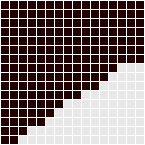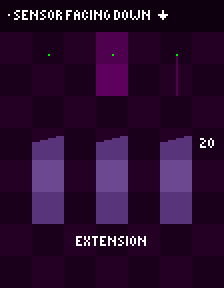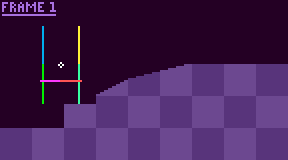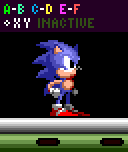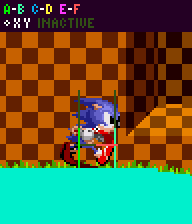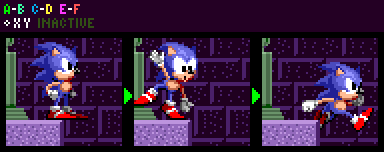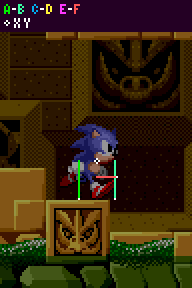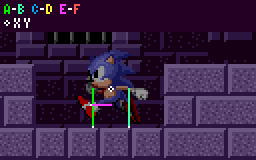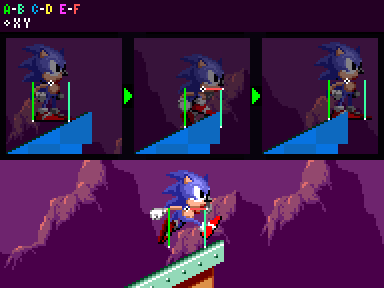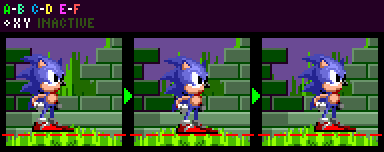SPG:Solid Tiles
From Sonic Retro
Notes:
- The research applies to all four of the Sega Mega Drive games and Sonic CD.
- Following only describes how Sonic collides and interacts with solid tiles. Solid objects, such as Monitors, Moving Platforms, and Blocks each have their own collision routines with Sonic and don't necessarily behave exactly the same as the tiles do. For this, refer to Solid Objects.
- Variables and constants for Sonic and other characters such as xpos and acc will be referenced frequently, they can be found in Basics.
- The original games use solid tiles, however the ideas and mechanics of Sonic's base collision setup can be adapted (with adjustments) to other engines using sprite masks, line intersections, etc.
- While 16x16 tiles are "officially" named blocks, they are being referred to as solid tiles here since they are a simple grid pattern of sets of data which can be read simply, as opposed to objects or any other method. "Solid Tiles" and "Blocks" can be used interchangeably in this guide.
Contents
Introduction
What are solid tiles? While there are often solid objects in Sonic zones, the zone itself would require far too much object memory if the environment were constructed entirely of solid objects, each with their own 64 bytes of RAM. A clever short-cut is used - the zone is constructed out of tiles anyway, so all that needs be done is have each tile know whether or not it is solid.
You may know that zones are broken down into 128x128 pixel chunks (or 256x256 pixel chunks in Sonic 1 and Sonic CD), which are in turn broken into 16x16 pixel blocks, which are again in turn broken into even smaller 8x8 pixel tiles. All of the solidity magic happens with the 16x16 blocks, so those are the only ones we will be interested in throughout this guide.
Sonic's collisions and interactions with these solid tiles are what make up his basic engine. They dictate how he handles floors, walls, ceilings, slopes, and loops.
First we will look at how the environment is constructed from tiles, and then Sonic's method for detecting his environment.
Solid Tiles
Solid tiles are a grid of data blocks, which represent solid areas within each grid cell. This area is defined using height masks.
Height Masks
When checking a solid tile, how is the height of the tile found?
Each tile has a value associated with it that references a mask stored in memory. Each mask is simply an array of 16 height values that range from 0px ($00) to 16px ($10) and an angle value.
This height mask, for example, has the height array 0 0 1 2 2 3 4 5 5 6 6 7 8 9 9 9, and the angle 33.75° ($E8).
Which value of the height array is used? Subtract the tile's X position from the sensor's X position. The result is the index of the height array to use.
If the height value found is 16px ($10), that's the entire tile filled at that X position, so then the sensor has to check for another tile above the first one found, and search for that one's height value.
Horizontal Axis
Solid Tiles also have another height array (or, well, a width array) for horizontal collisions. This other array represents the same data and creates the exact same shape within the tile. This is only possible because the shapes represented in tiles are usually smooth continuous slopes, which don't extend in one direction then regress back. but either continue sloping in the same direction or stop.
Flipping Tiles
You may rightly wonder hows sloped ceilings are possible if the height array starts at one end only. The answer to this is that tiles can be flipped horizontally or vertically. The collision systems take this into account when reading the height data from tiles.
Sensors
"Sensors" are simply checks performed by objects which look for solid tiles around them.
An x, y position (anchor point) is checked, and if it finds a solid tile, they will gather information about the tile. Sensors can point down, right, up, and left, and all behave the same in their respective directions.
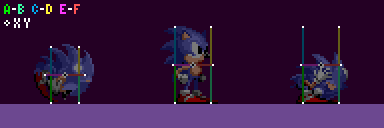 The white points represent the anchor positions of Sonic's sensors when uncurled.
The white points represent the anchor positions of Sonic's sensors when uncurled.
In this example, the sensor to Sonic's mid right points right, and those at Sonic's feet point down. Their direction dictates in which direction they are looking for a surface. A sensor pointing right is looking for the leftmost edge of solid terrain nearby, a sensor pointing down is looking for the topmost edge of solid terrain nearby.
So, we know they are points which look for solid tiles they touch. However, this is not the whole picture. If a sensor finds an empty tile or the array value of the tile found by the sensor is 16 (a full block amount), then it's likely that the surface of the solid terrain is actually found within an adjacent tile.
Sensor Regression & Extension
So when a sensor check is performed at a sensor's anchor point it has either found a solid tile, or it hasn't. If it has, what if the height value found is 16 and isn't actually the surface of the terrain? Or if it hasn't, what if there's a solid tile nearby?
Well, this is easily solved by checking nearby tiles also, until certain conditions are met.
In the case of a sensor which is pointing down looking for solids below:
Regression:
- If the anchor point finds a Solid Tile, and if the height array value at the sensor's x of that tile is 16, it will check up by 1 extra Solid Tile. We'll call this the "regression" since it goes back against the sensor direction.
- If a regression occurs and finds no solid in the second tile, the second tile will be ignored.
Extension:
- If the anchor point just finds an empty tile (height array value of 0), it will check down by 1 extra Solid Tile. We'll call this the "extension" because it goes outwards, in the direction of the sensor.
- If an extension occurs and finds no solid in the second tile, the second tile will be ignored.
If the extension/regression does not fail, the new tile is the one which is processed.
In the above example, a downward facing sensor moves down through 3 Solid Tiles. We can see the tiles it checks, and the distance it returns at each position. We can also see if it is performing extension or regression.
To reiterate, when the sensor is within a tile which has a height array value of 0 at the sensor's x position (empty) it will check another tile in the sensor direction (extension). If the tile's height value is between 0 and 16 (not inclusive), the surface of the terrain has been found without needing to check extra tiles. If the tile's height value is 16, it will check another tile opposite to the sensor direction (regression). If the regression still fails to find a tile with a surface within, it will still return the information of the second tile. If the extension fails to find any solid tile, the sensor will return a distance of 0.
The regression & extension will occur in the direction of the sensor, be it horizontal or vertical. If the sensor is horizontal, it reads the other height array belonging to the tile, using the sensor's y position. Essentially rotating the entire setup. So a right facing sensor's regression would check an extra tile to the left, and extension would check an extra tile to the right. While an upward facing sensor's regression would check an extra tile below, and extension would check an extra tile above.
With all this, a sensor can always locate the nearest open surface (and the tile containing that surface) of the terrain within a range of 2 tiles (the tile the sensor anchor point is touching plus another).
Reaction
Once a final suitable tile has been found, information about the tile is returned.
The information a sensor finds is as follows:
- The distance from the sensor pixel to the surface of the solid tile found (in the sensor's direction)
- The angle of the tile found
- The tile ID
Distance
The distance to the solid surface (found by the sensor) is the most important piece of information dictating how an object will react to solid tiles. It's not the distance to the tile, it's the distance to the edge of the solid area within the tile, precisely.
The distance can either be 0, negative, or positive. When no Solid Tile is found by a sensor, a distance of 0 is returned by default.
- A distance of 0 means the sensor is just touching the solid tile surface and does not need to move.
- A negative distance means the surface found is closer to the object than the sensor position. Negative distances are almost always reacted to when colliding, because it indicates that the object is inside the solid and can be pushed out.
- Positive distances mean the surface found is further away from the object than the sensor position. Since this means the object isn't actually touching the tile, it's rarely used - but not never. A notable example of it's use is by floor sensors of various objects, including Sonic to keep him attached to the ground even if the ground has sloped away from him a bit. Objects usually employ a limit to how far an object can be "pulled" down to a solid they aren't actually touching. This will be detailed further down.
If the object decides to snap itself to the terrain, it simply has to add distance value from it's position. Or subtract, depending on the sensor's direction. A sensor pointing left may return a negative distance if it is inside a solid, but the object would have to subtract the distance in order to move to the right, out of it.
Of course, as stated, this distance can be representative of any 4 directions, depending on the sensor's own angle.
Summary
Here's a demonstrative animation showing a very simplified process of how the floor sensors detect a tile and be moved upwards. In this case, Sonic will have a gsp of 6.
Sonic's Sensors
Like any object which wants to collide with tiles, sensors surround Sonic. Throughout this guide these sensors will be drawn as lines, as these are the areas which Sonic will not allow solid tiles to overlap. Though sensors are in fact single points and their checks extend in either direction regarding tiles, this visualisation is the most intuitive way to demonstrate Sonic's solid boundaries.
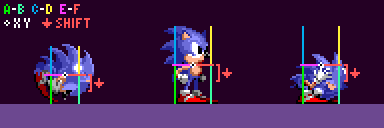 Sonic's solidity for tiles. When solid tiles overlap these areas, he will be pushed out.
Sonic's solidity for tiles. When solid tiles overlap these areas, he will be pushed out.
A and B - Floor collision C and D - Ceiling collision (only used mid-air) E and F - Wall collision (shifting by 8px depending on certain factors, which will be explained) XY - Sonic's xpos and ypos
Since Sonic's collision setup is symmetrical, it makes sense for the game to set up widths and heights using radius values. Sonic has separate radius values for his E and F sensor pair (his Push Radius) which always remains the same, and for his A, B, C and D sensors there is a width radius (his Body Width Radius) and height radius (his Body Height Radius) both of which will change depending on Sonic's state.
Note on sprite alignment:
- Sonic's sprite is 1 pixel offset to the left when he faces left, which can result in him appearing to be 1px inside a tile when pushing leftwards. Amusingly, this offset will appear corrected when pushing most objects thanks to their hitboxes sticking out 1px further on their right and bottom (due to their origins being off-centre by 1 in X and Y). So while tiles are collided with accuracy, it will appear the opposite in-game. More about object collision in Solid Objects.
Floor Sensors (A and B)
A and B sit at his feet at ypos+Body Height Radius.
Movement
Typically, Sonic's Body Width Radius is 9, placing A on Sonic's left side, at xpos-9. While B should be on his right, at xpos+9, 19 pixels wide. His Body Height Radius is usually 19, making him 39 pixels tall in total.
However while rolling or jumping, his Body Width Radius becomes 7, placing A at xpos-7. With B at xpos+7, 15 pixels wide. This is to ensure Sonic doesn't appear too far away from the floor at steep angles while in curled up. Crouching does not affect his Body Width Radius.
Here's an example of that in action:
While rolling or jumping (and otherwise generally curled up), Sonic's Body Height Radius becomes smaller at a value of 14, making him 29 pixels tall. Because of this, in the step in which Sonic rolls or jumps or otherwise becomes shorter, the engine adds 5 to his ypos so that his bottom point will remain unchanged despite him getting shorter and his center changing position. 5 also has to be subtracted from ypos when he unrolls or lands from a jump. The camera system also has to keep this offset in mind, otherwise, the view will jump when Sonic changes height.
Method
Assuming the ground level to be at a Y position of 736 ($02E0), while standing Sonic is atop it at a ypos of 716 ($02CC), which is 20 pixels above ground level.
Floor sensors are a special case, there are 2 sensors and they need to detect slopes. Both sensors behave the same and search for a Solid Tile. The smaller distance is the sensor that wins. For example, -10 is a smaller distance than 5. The sensor that wins is the distance and angle used (and it's found tile is the one referenced).
Once the winning distance is found, it can be used to reposition Sonic.
Distance Limits
As we know, sensors return a distance to the nearest surface, up to an extreme maximum of 32 pixels. If Sonic's floor sensors are within 32 pixels of the floor, the game may know the floor is there but we might not just want him to snap down right away. The game will test the distance found and react appropriately.
While grounded:
In Sonic 1, if the distance value is less than -14 or greater than 14, Sonic won't collide. In Sonic 2 onward however the positive limit depends on Sonic's current speed - in this case, (for when Sonic is on the floor) if the distance is greater than
minimum(absolute(xsp)+4, 14)
then he won't collide. So the faster Sonic moves, the greater the distance Sonic can be from the floor while still being pulled back down to it. The -14 limit remains the same.
If Sonic was in a sideways mode, such as on a wall, it would use ysp instead.
While airborne:
While airborne, if the distance value is greater than or equal 0 (meaning the sensor isn't touching the floor yet) Sonic won't collide.
Ledges
Sonic has to be able to run off of ledges. It would not do to just keep walking like Wile E. Coyote, not noticing that there is nothing beneath him.
If both sensor A and B detect no solid tiles, Sonic will "fall" - a flag will be set telling the engine he is now in the air.
Balancing On Edges
One nice touch is that Sonic goes into a balancing animation when near to the edge of a ledge. This only happens when he is stopped (his gsp is 0).
How does the engine know? It is simple - any time only one of the ground sensors is activated, Sonic must be near a ledge. If A is active and B is not the ledge is to his right and vice versa.
But if Sonic began balancing the instant one of the sensors found nothing, he would do it too "early", and it would look silly. So it only happens when only one sensor is active, and xpos is greater than the edge of the solid tile found by the active sensor.
Assuming the right edge of the ledge to be an X position of 2655 ($0A5F), Sonic will only start to balance at an xpos of 2656 ($0A60) (edge pixel+1). He'll fall off at an xpos of 2665 ($0A69) (edge pixel+10) when both sensors find nothing.
In Sonic 2 and Sonic CD, if the ledge is the opposite direction than he is facing, he has a second balancing animation.
In Sonic 2, Sonic 3, and Sonic & Knuckles, Sonic has yet a third balancing animation, for when he's even further out on the ledge. Assuming the same values as above, this would start when he is at an xpos of 2662 ($0A66).
Note: While balancing, certain abilities are not allowed (ducking, looking up, spindash, etc). In Sonic 3 & Knuckles, the player is still allowed to duck and spindash (not to look up, though) when balancing on the ground but not when balancing on an object.
Ceiling Sensors (C and D)
Sonic's C and D sensors are always an exact mirror image of Sonic's floor sensors, they have the same X positions and length but are flipped upside down.
They perform in the exact same way simply up instead of down.
However, they aren't active at the same times.
Method
When these sensors find a ceiling, much like the floor sensors the sensor which finds the smallest distance will win. The sensor that wins is the distance and angle used (and it's found tile is the one referenced). This winning distance can then be subtracted from Sonic's position.
Distance Limits
Distance limits here work in the same way as the floor sensors while airborne.
Wall Sensors (E and F)
E sits at his left at xpos-Push Radius, while F sits at his right at xpos+Push Radius.
Movement
Push Radius is always 10, placing E to Sonic's left side, at xpos-10. While F is to his right, at xpos+10, giving Sonic a total width of 21 pixels when pushing.
Sensors E and F Spend most of their time at Sonic's ypos however while Sonic's ang is 0 (on totally flat ground) both wall sensors will move to his ypos+8 so that he can push against low steps and not just snap up ontop of them.
The horizontal sensors are always positioned at ypos while airborne.
You may remember that sensors A and B are only 19 pixels apart but Sonic is 21 pixels wide when pushing into walls. This means that Sonic is skinnier by 2 pixels when running off of ledges than when bumping into walls.
Method
Assuming the wall's left side to be at an X position of 704 ($02C0), Sonic cannot get closer than an xpos of 693 ($02B5). Assuming the wall's right side to be at an X position of 831 ($033F), Sonic cannot get closer than an xpos of 842 ($034A). Thus the distance between both sensors inclusive should be 21 pixels, stretching from Sonic's xpos-10 to xpos+10.
When Sonic collides with a wall, this will set his gsp to 0 if he is moving in the direction of the wall, not away from it.
The distance value found by the sensor in it's given direction is used to push Sonic out of a wall.
Distance Limits
The distances found by the wall sensors are reacted to depending on the size.
While Grounded:
As noted in Main Game Loop wall collision (while grounded) actually takes place before Sonic's position physically moves anywhere, so he wont actually be in a wall when he tries to collide with it. The game accounts for this by actually adding his xsp and ysp to sensor's position. This is where the sensor would be if Sonic had moved yet.
If the distance is negative, he will of course collide because he will be inside the wall when he moves. The game will ignore a positive distance.
In this case, instead of using the distance to reposition Sonic, the game smartly uses the fact that Sonic has still yet to move within the current frame. All it has to do is subtract the distance from Sonic's xsp (if moving right, or add the distance to Sonic's xsp if moving left. This would be done to ysp if in wall mode). This results in Sonic moving when his position changes, right up to the wall, but no further. In the next frame, because gsp has been set to 0, Sonic will have stopped just like in any other situation.
While Airborne:
If the distance is negative and the sensor is inside the wall, he will collide. The game will ignore a positive distance.
Extra Sensors
Sonic cannot jump when there is a low ceiling above him. If there is a collision detected with sensors at Sonic's xpos-9 and xpos+9, at ypos-25, Sonic won't bother jumping at all.
Sensor Activation
Knowing where the sensors are and what they do is only half the job since they are only sometimes active. This depends while you are grounded or airborne.
While Grounded
Floor Sensors A and B are always active while grounded, and will use their 1 tile extension to actively search for new floor below Sonic's feet.
When grounded, Wall Sensors E and F only activate when Sonic is walking in that direction. For example, while standing still Sonic isn't checking with his wall sensors at all, but while gsp is positive, Sonic's E sensor is inactive, and while gsp is negative, Sonic's F sensor is inactive.
However this is not always the case, both wall sensors simply don't appear when Sonic's ang is outside of a 0 to 90 and 270 to 360 (or simply -90 to 90) degree range, meaning when you running around a loop, the wall sensors will vanish for the top half of the loop. In S3K however these sensors will also appear when Sonic's 'ang' is a multiple of 90 in addition to the angle range.
While grounded Ceiling Sensors C and D are never active, and Sonic won't check for collision with solid tiles above himself while on the floor.
While Airborne
While in the air, all sensors play a part to find ground to reattach Sonic to. But rather than have all active at once and risk lag, only 4-5 will be active at any given time.
As you move, the game will check the angle of your motion (xsp and ysp) through the air. It will then pick a quadrant by rounding to the nearest 90 degrees. (this is different to the Mode, this is simply a measurement of if you are going mostly left, right up or down). The quadrant can be more easily found by simply comparing the xsp and ysp and finding which is larger or smaller.
if absolute xsp is larger then or equal to absolute ysp then
if xsp is larger than 0 then
Sonic is going mostly right
else
Sonic is going mostly left
else
if ysp is larger than 0 then
Sonic is going mostly down
else
Sonic is going mostly up
Depending on the quadrant, different sensors will be active.
When going mostly right, Sonic's F sensor will be active, along with both A and B floor sensors and the C and D ceiling sensors.
When going mostly left, it is the exact same as going right, but the E wall sensor instead.
When going mostly up, both the C and D ceiling sensors and the E and F wall sensors are active.
When going mostly down, it is the same as going up, but the A and B floor sensors are active instead of the ceiling sensors.
Summary
Here's a handmade visualisation of how sensors interact with solid tiles (here highlighted in bright blue, green, and cyan). You can notice how the sensors are pushing Sonic from the ground tiles, and is overall rather simple. The E and F sensors lower when on flat ground. You can also notice the sensors snap in 90 degree rotations resulting in four modes, this is covered in Slope Physics.
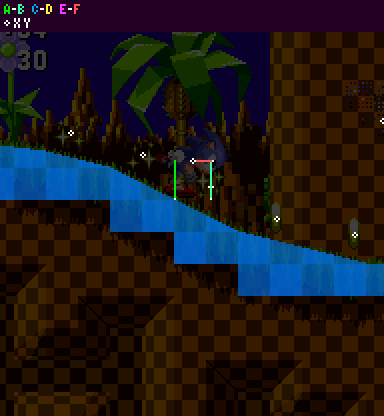 Keep in mind, while on the ground the upper C and D sensors would not exist, and while gsp is positive the left wall sensor would also not appear. These sensors are only included for illustration purposes.
Keep in mind, while on the ground the upper C and D sensors would not exist, and while gsp is positive the left wall sensor would also not appear. These sensors are only included for illustration purposes.
Bugs Using This Method
Unfortunately, there are a couple of annoying bugs in the original engine because of this method.
If Sonic stands on a slanted ledge, one sensor will find no tile and return a height of foot level. This causes Sonic to be set to the wrong position.
Sonic raises up with sensor B sensor as he moves right. When B drops off the ledge, Sonic defaults to the level of sensor A. Then he raises up with sensor A as he moves further right. So he will move up, drop down, and move up again as he runs off the ledge.
There are only a few areas where this is noticeable, but it applies to all Mega Drive titles and is pretty tacky.
The second form of it occurs when two opposing ramp tiles abut each other, as in some of the low hills in Green Hill Zone and Marble Zone.
Sensor B starts climbing down the ramp on the right, but Sonic still defaults to the level of the previous ramp found by sensor A. Because these ramps are usually shallow, this only causes him to dip down in the middle by about 1 pixel.
But that is not all. Because the highest sensor is the one Sonic gets the angle from, even though it looks like he should be considered to be at the angle of the ramp on the right (because he is closer to it), he will still have the angle of the ramp on the left. When you jump, he will jump at that angle, moving backward, not forward like you would expect.
Notes
- Find information on how Sonic's momentum and slope handling work in the Slope Physics guide.
